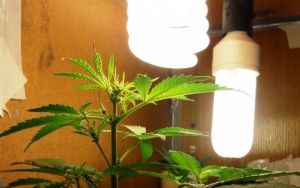High-Intensity Discharge (HID) bulbs are a type of electrical lamp used for cannabis lighting which produces light utilizing an electric arc between tungsten electrodes housed inside a translucent or transparent fused quartz or fused alumina arc tube.
This tube is filled with both gas and metal salts, the gas facilitates the arc’s initial strike.
Once the arc is started, it heats and evaporates the metal salts forming the plasma which greatly increases the intensity of light produced by the arc as well as reduces its power consumption. High-intensity discharge lamps are a type of arc lamp.
HID lamps make more visible light per unit of electric power consumed than fluorescent and incandescent lamps since a greater proportion of their radiation is visible light.
The various types of chemistry used in the arc tubes of HID lamps depend on the desired characteristics of light intensity, correlated color temperature, color rendering index (CRI), energy efficiency, and lifespan. Types of HID bulbs include:
- Metal Halide
- High-Pressure Sodium
- Conversion
- Mercury Vapor
Cannabis Lighting Systems
Metal Halide HID lamps are the most efficient source of artificial white light that is available today. There are many sizes of metal halide bulbs, they include sizes from:
- 175 watts
- 250 watts
- 400 watts
- 1,000 watts
- 1,100 watts
- 1,500 watts
Many indoor growers prefer to use 1,000-watt halide systems for cannabis lighting over most all other sizes. Halide bulbs come in clear and phosphor coating, yet super halides can produce fifteen percent (15%) more lumens than standard halides.
Clear halides are used most often by indoor growers to supply plants with bright lumens. Metal halide lamps produce light by passing electricity through vaporized argon gas, which are mercury, thorium iodide, sodium iodide, and scandium iodide within a quartz crystal arc tube.
Bulb Protective Coverings
The outermost part of the bulb functions as a protective covering that contains the arc tube and starting mechanism for the bulb, this keeps the internal components in a stable, constant environment while shielding and containing most UV rays.
Be sure not to look at or stare at the bulb for long since UV rays can be harmful to your eyes. When the lights are started they use an incredible amount of voltage for ionization to take place within the bulb.
It is always best to use timers to control your lights to keep your lighting cycles consistent with the cannabis lighting. Shutting down and restarting your bulbs multiple times in a day will degrade the bulb faster which causes less lifespan than turning them on/off only once throughout the day.
Metal halides operate at their most efficient peak in a horizontal or vertical plus/minus 15-degree position and this is due to the arc bends when the light is on. If this arc does not bend properly it will create non-uniform heating of the arc tube wall and result in a shorter lifespan.
The average life of a metal halide is about 12,000 hours, which is almost two years of daily operation using an 18/6 day/night running cycle.
Be sure not to wait until the bulb is burned out before changing it since old bulbs run inefficiently, which produce less lumen output and can be more costly to keep (less production) as cannabis lighting. Many times, growers will change out the metal halide bulbs every year to keep their productivity high.
When metal halide lights start up they will create a stroboscopic (flashing) effect so this is normally expected during their operation. With metal halide bulbs they will first appear bright then go back and forth between being dim and bright, this is due to the bulb starting and then extinguishing about 120 times every second.
Ballasts & Light Bulbs
Different ballasts are required for each type of light bulb based on whether they are High-Pressure Sodium (HPS) or Metal Halide (MH) and their varying wattage sizes and starting requirements.
Ballast for metal halides will operate all halides (super or standard & clear or phosphorus coated) that are the same wattage, but not metal halides that run off of different wattages.
Ballasts that are made for 1,000 watts are only for 1,000 watts, therefore, ballasts for 400 watts are only for 400 watts, and so on.
If a different ballast and wattage bulb are put together could result in them not working, the bulb blowing, etc. Each is specifically designed for the watts’ unique starting and operating requirements.
Universal metal halide bulbs are designed to operate in any position though typically have a shorter lifespan and up to ten percent (10%) less lumen output. Some companies enhance their bulbs with additional elements that will contribute to either more or a larger spectrum of, lighting.
Let us know what you think.








Responses